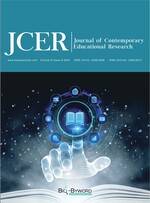Abstract
Based on the theory of collaborative innovation and the triple helix theory combined with the needs for innovative development in the modern manufacturing industry in Guangdong Province, the construction of open bases as education carriers by the governments was explored in terms of implement joint training for postgraduates in engineering through the integration of science-education and industry-education, to improve the practical innovation ability of postgraduates in engineering. The integration training mode has significantly improved the effectiveness of collaborative education and innovation, and it has become an important talent and intellectual support for Guangdong’s modern manufacturing industry. It has further advanced the theory and practice of joint training conducted by governments, industries, universities, and scientific research institutes.
References
Ministry of Education, 2020, Notice on Printing and Distributing the Professional Degree Postgraduate Education Development Plan (2020-2025), September 25, 2020. http://www .moe.gov.cn/srcsite/A22/moe_826/202009/t20200930_492590.html
Wang WL, Li XM, Xiao MD, et al., 2015, Analysis of the Driving Factors of School-Enterprise Collaborative Innovation: Taking Henan Agricultural University as an Example. Research on Technology Economy and Management, 2015(01): 26–31.
Gu YD, Liu ZX, Lu Y, 2022, Innovative Practice of Integration of Production and Education for Engineering Graduate Students under the Model of Industrial Colleges. University Education Management, 2022(04): 105–113. http://org.doi.10.13316/j.cnki.jhem.20220615.0
Academic Affairs Office of ShanghaiTech University, 1984, On Joint University Running by Science and Engineering Universities and Bureaus, Institutes and Other Universities. Shanghai Higher Education Research, 1984(3): 59–63.
Zhang XC, 2019, Reflections and Explorations on the Cultivation of Innovative Talents in Universities During the Construction of the Guangdong-Hong Kong-Macao Greater Bay Area. Higher Engineering Education Research, 2019(1): 99–102.
Zhao CH, 2019, Research on the Education Mode of the Integration of Industry and Education under the Background of New Engineering: Taking Xidian University as an Example, Xidian University, Xi’an.
Li CF, 2012, Exploration and Practice of College-enterprise Joint Training Mode for Engineering Master Students. Technology and Innovation Management, 2012(4): 428–430.
Dong ZC, Liu PL, Zhou L, et al., 2016, Analysis on the Construction of Engineering Postgraduate Training Bases. Academic Degree & Graduate Education, 2016(8): 21–24.
Chu XX, Huang YR, Yang Q, 2018, Research on the Construction Model of the Joint Training Base for Industry-University-Research Graduate Students: Based on the Analysis of the Joint Training Practice Base for Sewage Treatment Graduate Students in Beijing University of Technology. Degree and Graduate Education, 2018(10): 31–35. http://org.doi.10.16750/j.adge.2018.10.006
Liu CF, 2018, Discussion on the Integrated Education Model of Industry, University, and Research. Science and Technology in Chinese Universities, 2018(03): 67–68. http://org.doi.10.16209/j.cnki.cust.2018.03.023
Wei J, Ji HB, Gao XL, 2018, Reflections and Suggestions on the Reform of the Graduate Training Program for Engineering Master’s Degrees. Graduate Education Research, 2018(03): 30–35.
Yu RH, Li Q, Zheng XD, et al., 2020, Discussion on the Construction of Joint Training Base for Fishery Development Professional Degree Graduate Students. Education Modernization, 7(56): 17–19 + 31. http://org.doi.10.16541/j.cnki.2095-8420.2020.56.005
Jiang WJ, 2018, Research on the Collaborative Education Mechanism of the Integration of Scientific Research and Education in China: From the Perspective of Cooperation between Scientific Research Institutes and Institutions of Higher Learning, University of Science and Technology of China, Hefei.
Ma YH, Chen D, 2018, Research on the Dynamic Mechanism of Enterprise Participation in School-Enterprise Cooperative Education: Based on the Perspective of Economic Interest and Social Responsibility. Higher Education Exploration, 2018(03): 5–13.
Zhao DX, Wang M, Lu HB, 2021, Exploration and Practice of Multi-subject Collaborative Engineering Degree Graduate Training Model. Degree and Graduate Education, 2021(12): 9–19. http://org.doi.10.16750/j.adge.2021.12.002
Yang Y, 2019, The Logic and Way Out of the Construction of Professional Degree Postgraduate Education Practice Base: Based on the Research of Engineering Master Education Practice Base. Education Science, 35(05): 92–96.
Zheng HZ, Chu DH, 2014, Exploration of the Innovative Ability of Postgraduates under Joint Training through Innovation Platforms as well as the Industry, Universities and Scientific Research Institutes. Chinese University Science & Technology, 2014(05): 82–83.
Ma YH, Zhang L, Gao YF, et al., 2016, Analysis on the Status of Joint Training Practice Bases for Engineering Masters in China: Based on 28 Engineering Masters Demonstration Bases. Academic Degree & Graduate Education, 2016(4): 5.
Zhang SL, Qian YL, Pei X, et al., 2019, Realistic Review and Advancing Path of the Joint Training of Engineering Masters through the Integration of Industry and Education in China: Based on an Empirical Analysis of 108 Joint Training Bases across the Country. China Higher Education Research, 2019(3): 6.
Li JL, 2015, Research on the Reform of the Postgraduate Joint Training Mechanism under the Collaborative Innovation Environment, University of Science and Technology of China.
Wu Y, 2020 Empowering the Future by Taking the Lead: Leading the Reform of Higher Education with New Engineering Construction. Higher Engineering Education Research, 2020(2): 1–5.
